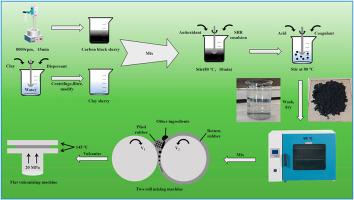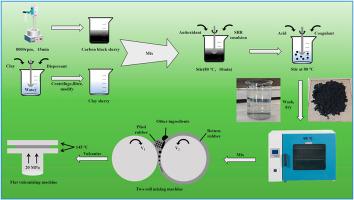乳液共混制备丁苯橡胶/粘土/炭黑纳米复合材料:实现性能调整,减少粉尘污染
IF 10
1区 环境科学与生态学
Q1 ENGINEERING, ENVIRONMENTAL
引用次数: 0
摘要
凹凸棒石和蒙脱土矿物经处理后得到水分散。采用乳液共混法制备了丁苯橡胶(SBR)/粘土纳米复合材料,并按照评价SBR的标准试验方法制备了硫化橡胶。粘土在纳米尺度上分散在橡胶基体中,纳米复合材料表现出增强的热稳定性。用石蜡油润湿粘土表面提高了纳米复合材料的可加工性。与仅用炭黑补强橡胶相比,用粘土代替橡胶可使橡胶的100%恒伸长应力提高27%,而部分用粘土代替炭黑可使橡胶的伸长率从424.5%提高到554.0%。机械性能可以通过改变橡胶、粘土和炭黑的比例来调节。在此基础上,为了减少后续机械混合污染,缩短混合时间,将炭黑分散在水中,采用乳液共混的方法制备了SBR/粘土/炭黑纳米复合材料。与机械共混相比,乳液共混制备的SBR/粘土/炭黑纳米复合材料具有更好的力学性能、湿滑性和更低的滚动阻力。这种方法可以使粘土减少最终橡胶制品中所需的生胶和炭黑的用量,从而在生产过程中减少石油消耗,降低成本,减少碳排放,减少污染。这符合绿色化学和清洁生产的原则,在橡胶工业中具有良好的应用价值。本文章由计算机程序翻译,如有差异,请以英文原文为准。


Preparation of styrene-butadiene rubber/clay/carbon black nanocomposite by emulsion blending: Achieve performance adjustment and reduce dust pollution
Attapulgite and montmorillonite minerals were processed to achieve an aqueous dispersion. Styrene-butadiene rubber (SBR)/clay nanocomposites were prepared through emulsion blending, and vulcanized rubbers were prepared according to the standard test method for evaluating SBR. The clay was dispersed at the nanoscale within the rubber matrix, and the nanocomposite exhibited an enhanced thermal stability. Wetting the clay surface with paraffin oil improved the processability of the nanocomposites. Compared with rubber reinforced only with carbon black, substituting rubber with clay led to a 27 % increase in 100 % constant elongation stress, while also increasing the elongation from 424.5 % to 554.0 % when carbon black was partially replaced by clay. The mechanical properties can be adjusted by varying the ratios of rubber, clay, and carbon black. Based on this, in order to reduce subsequent mechanical mixing pollution and decrease the mixing time, carbon black was dispersed in water, and SBR/clay/carbon black nanocomposites were prepared using emulsion blending. Compared with the mechanical mixing, the SBR/clay/carbon black nanocomposites prepared using emulsion blending exhibited better mechanical properties, wet skid resistance, and lower rolling resistance. This approach allows the clay to reduce the amount of raw rubber and carbon black required in the final rubber products, thereby reducing petroleum consumption, lowering costs, reducing carbon emissions, and reducing pollution during the production process. This aligns with the principles of green chemistry and cleaner production and demonstrates its promising application value in the rubber industry.
求助全文
通过发布文献求助,成功后即可免费获取论文全文。
去求助
来源期刊

Journal of Cleaner Production
环境科学-工程:环境
CiteScore
20.40
自引率
9.00%
发文量
4720
审稿时长
111 days
期刊介绍:
The Journal of Cleaner Production is an international, transdisciplinary journal that addresses and discusses theoretical and practical Cleaner Production, Environmental, and Sustainability issues. It aims to help societies become more sustainable by focusing on the concept of 'Cleaner Production', which aims at preventing waste production and increasing efficiencies in energy, water, resources, and human capital use. The journal serves as a platform for corporations, governments, education institutions, regions, and societies to engage in discussions and research related to Cleaner Production, environmental, and sustainability practices.
 求助内容:
求助内容: 应助结果提醒方式:
应助结果提醒方式:


